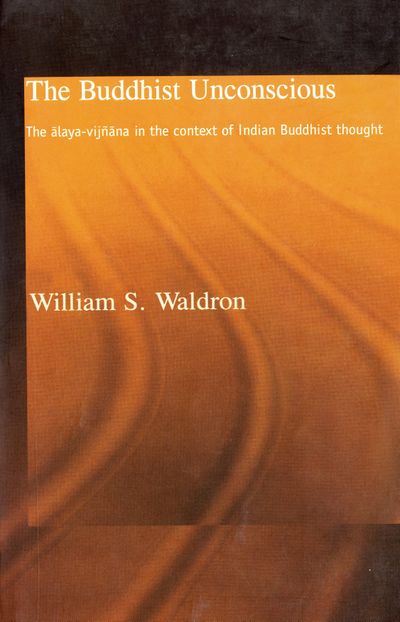No edit summary |
No edit summary |
||
| Line 41: | Line 41: | ||
*{{i|'''PART II<br>The ālaya-vijñāna in the Yogācāra tradition'''|89}}<br><br> | *{{i|'''PART II<br>The ālaya-vijñāna in the Yogācāra tradition'''|89}}<br><br> | ||
*{{i|'''3 The ālaya-vijñana in the early tradition'''|91}} | *{{i|'''3 The ālaya-vijñana in the early tradition'''|91}} | ||
*{{i|''The origins of the ālaya-vijñāna''|91}} | |||
*{{i|''The new model of mind in the'' Saṃdhinirmocana Sūtra|94}} | |||
**{{i|The ālaya-vijñāna as mental stream|99}} | |||
*{{i|''The'' Ālaya Treatise ''of the'' Yogācārabhūmi|101}} | |||
**{{i|The ''Proof Portion''|102}} | |||
*{{i|''The'' Alaya Treatise, Pravṛtti Portion: ''analyzing the ālaya-vijñāna in Abhidharmic terms''|107}} | |||
**{{i|The ālaya-vijñāna's subliminal objective supports and cognitive processes|109}} | |||
**{{i|The ālaya-vijñāna's mutual and simultaneous relationship with manifest cognitive awareness (''pravṛtti-vijñāna'')|112}} | |||
**{{i|The ālaya-vijñāna's simultaneous arising with (afflictive) mentation|117}} | |||
*{{i|''The'' Ālaya Treatise, Nivṛtti Portion: ''equating the ālaya-vijñāna with saṃsāric continuity''|123}} | |||
*{{i|''Conclusion''|127}}<br><br> | *{{i|''Conclusion''|127}}<br><br> | ||
*'''4 The ālaya-vijñāna in the ''Mahāyāna-saṃgraha'' '''<br> | *'''4 The ālaya-vijñāna in the ''Mahāyāna-saṃgraha'' '''<br> | ||
*{{i|'''1. bringing it all back home'''|128}} | *{{i|'''1. bringing it all back home'''|128}} | ||
Appropriating the traditional Buddhist framework 129 | *{{i|''Appropriating the traditional Buddhist framework''|129}} | ||
Synonyms of the | **{{i|Synonyms of the ālaya-vijñāna in the disciple’s vehicle|130}} | ||
The two vijñanas and the two dependent arisings 131 | **{{i|The two vijñanas and the two dependent arisings|131}} | ||
Seeding the | **{{i|Seeding the ālaya-vijñāna: the karmic process as simultaneous intrapsychic causality|135}} | ||
simultaneous intrapsychic causality 135 | *{{i|''Resolving the Abhidharmic Problematic''|139}} | ||
Resolving the Abhidharmic Problematic 139 | **{{i|Karma, rebirth, and the ālaya-vijñāna|140}} | ||
Karma, rebirth, and the | **{{i|The continuity of the afflictions (''kleśa'')|142}} | ||
The continuity of the afflictions ( | **{{i|The path of purification: mundane and supramundane|150}} | ||
The path of purification: mundane and supramundane 150 | *{{i|''Beyond Abhidharma: adventitious defilements, pure seeds, and luminous minds''|153}}<br><br> | ||
Beyond Abhidharma: adventitious defilements, pure seeds, | |||
and luminous minds 153 | *'''5 The ālaya-vijñāna in the ''Mahāyāna-saṃgraha'' '''<br> | ||
5 The | *{{i|'''2. looking beyond'''|158}} | ||
2. looking beyond 158 | *{{i|''The predispositions of speech, self-view, and the life-constituents''|159}} | ||
The predispositions of speech, self-view, and the | *{{i|''Common experience, common embodiment: language, the ālaya-vijñana, and "the arising of the world"''|160}}<br><br> | ||
life-constituents 159 | |||
Common experience, common embodiment: language, | *{{i|'''PART III<br>Appendices'''|171}}<br><br> | ||
the | *{{i|Appendix I The series of dependent arising: affliction, action, and their results|173}} | ||
PART III | *{{i|Appendix II Index of related controversies|175}} | ||
Appendices 171 | *{{i|Appendix III Translation: the ''Pravṛtti'' and ''Nivṛtti Portions'' of | ||
Appendix I The series of dependent arising: affliction, | the ''Viniścayasaṃgrahaṇī'' of the ''Yogācārabhūmi''|178}}<br><br> | ||
action, and their results 173 | **{{i|''Notes''|190}} | ||
Appendix II Index of related controversies 175 | **{{i|''Bibliography of works cited''|247}} | ||
Appendix III Translation: the | **{{i|''Index of texts quoted''|255}} | ||
the | **{{i|''Index''|259}} | ||
Notes 190 | |||
Bibliography of works cited 247 | |||
Index of texts quoted 255 | |||
Index 259 | |||
|AddRelatedTab=No | |AddRelatedTab=No | ||
}} | }} | ||
Revision as of 16:31, 2 June 2020
This is the story of fifth century CE India, when the Yogacarin Buddhists tested the awareness of unawareness, and became aware of human unawareness to an extraordinary degree. They not only explicitly differentiated this dimension of mental processes from conscious cognitive processes, but also offered reasoned arguments on behalf of this dimension of mind. This is the concept of the 'Buddhist unconscious', which arose just as philosophical discourse in other circles was fiercely debating the limits of conscious awareness, and these ideas in turn had developed as a systematisation of teachings from the Buddha himself. For us in the twenty-first century, these teachings connect in fascinating ways to the Western conceptions of the 'cognitive unconscious' which have been elaborated in the work of Jung and Freud.
This important study reveals how the Buddhist unconscious illuminates and draws out aspects of current western thinking on the unconscious mind. One of the most intriguing connections is the idea that there is in fact no substantial 'self' underlying all mental activity; 'the thoughts themselves are the thinker'. William S. Waldron considers the implications of this radical notion, which, despite only recently gaining plausibility, was in fact first posited 2,500 years ago. (Source: Routledge)
| Citation | Waldron, William S. The Buddhist Unconscious: The Ālaya-Vijñāna in the Context of Indian Buddhist Thought. Routledge Critical Studies in Buddhism. London: RoutledgeCurzon, 2003. http://abhidharma.ru/A/Raznoe/0061.pdf. |
|---|---|

